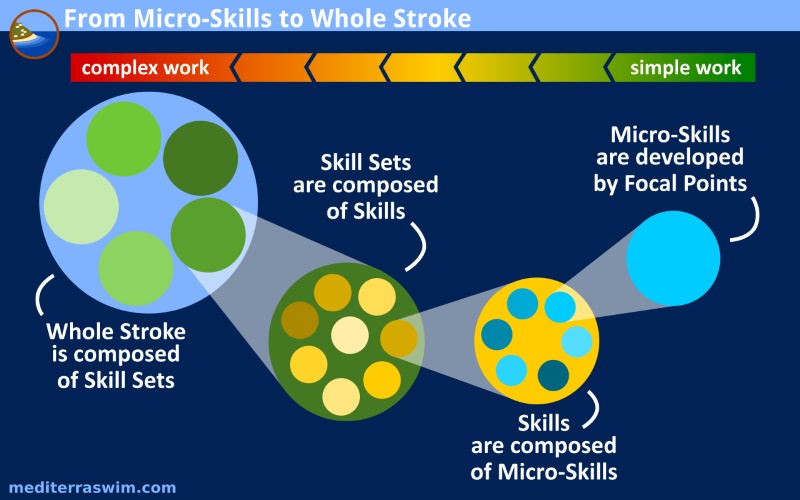Choosing Your Activities and Complexity Level
by Admin Mediterra | Sep 24, 2020 | Practice Design
When designing or remodeling a practice for your own personal needs, you need to select the right activities and the challenge (complexity) level that fits your needs.
Once you have chosen your skill project for the practice set, you need to choose the activities and quantities to use in that set. When you experienced a live training experience with your coach, he/she was making those decision for you, but they were also setting an example for how this works.
In your lesson notes you will see that the activities are listed in the order of their complexity for the neuro-muscular system, starting with most simple activity in which to practice control, to the most challenging activity.
Complexity Made More Simple
Not much can be done to reduce the overall complexity of swimming smoothly. But we have an effective way to break down that complexity into smaller pieces we can master, one by one, then gradually blend together into a marvelous stroke.

The complexity of the full freestyle stroke is broken down into skill sets. In each set there are skills, and each skill can be further broken down into micro-skills. In our approach we use cues which are specific commands we give to our body parts, to train them for their role in that full stroke.
Practice Activities
You will need to choose activities for each assignment that fit the level of complexity your brain needs – activities that fits your skill, your fitness, and your pace of learning.
This is a menu of activities that you may use to develop your control over each skill. These are in the order of their complexity for the neuromuscular system, starting with most simple activity in which to practice control, moving to the most challenging activity.
- Standing Rehearsal
- Drill (with no strokes)
- Drill plus 4 strokes (no breathing)
- 8 whole strokes (no breathing)
- 8 whole strokes (with breathing)
- One single length
- Multiple lengths with rest between
- Multiple lengths with no rest between
We recommend that you choose three of these to use in a practice set, and use them in the order of complexity.
You may use a lower complexity activity as a form of active rest between rounds with more difficult activities.
Choose Your Complexity Level
Level 1 – Choose activities from 1 to 4
- Standing Rehearsal
- Drill (with no strokes)
- Drill plus 4 strokes (no breathing)
- 8 strokes (no breathing)
Generally, at Level 1 we encourage you to do short segments within the amount of time you can hold your breath comfortably. Wait to add breathing after you have started to work on the breathing skills.
Level 2 – Choose activities from 3 to 6
- Drill plus 3 or 4 strokes (no breathing)
- 8 strokes (no breathing)
- 8 whole strokes (with breathing)
- One single length
This level assumes you can swim across the pool without great stress, and have some control over your stroke. It assumes you can breathe while swimming without great struggle. If not, consider working with Level 1 activities for a while.
Level 3 – Choose activities from 4 to 8
- 8 strokes (no breathing)
- 8 whole strokes (with breathing)
- One single length
- Multiple lengths with rest between
- Multiple lengths with no rest between
You may feel you can start at Level 3 for some of the skills, and that is OK. But at any time you run into a skill that is difficult to get control over, we recommend that you switch to a lower level for a while to get your first sense of control. Once you can consistently get control over it at a lower level, you may switch back up to a higher one.
Fine-Tune The Complexity
To make the practice sets fit your skill level and time just right, you may adjust the activities in these ways:
- add or remove one practice set
- adjust the number of repeats in a set
- adjust the distance or duration of each repeat
- adjust the amount of rest you take between repeats or sets
- add a Tempo Trainer that is set to a comfortable (easy) tempo – not too fast, not too slow
